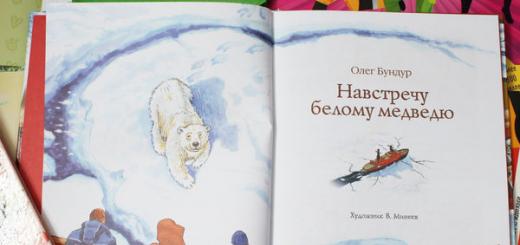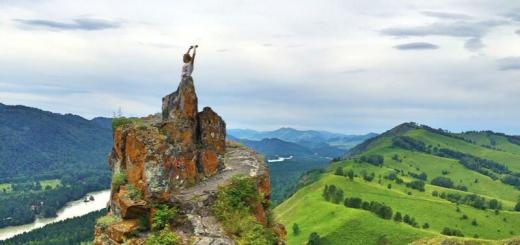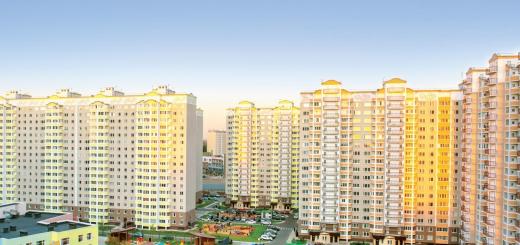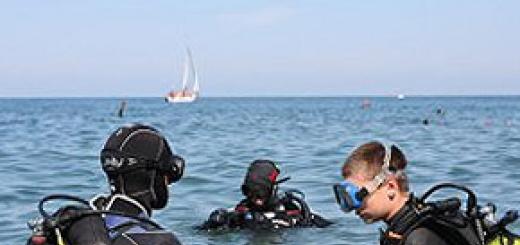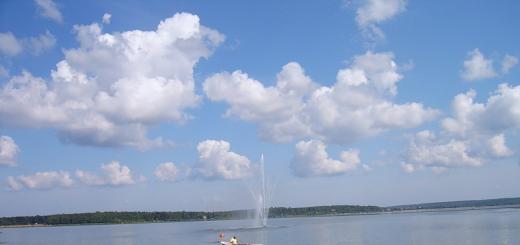Large freshwater lakes are now a rarity on the planet earth, they can be easily counted, such lakes are mainly located on the territory of our state of Russia. The wide and spacious expanse of the lake surprises a person who finds himself on its shores for the first time, there are a lot of coniferous forests that come close to the shore Lake Ladoga. In pine forests, you can find a large number of stone boulders covered with moss, these stones may have been brought by the water element that once hit the ground. There are a lot of islands on the lake, mostly of a rocky type, on the banks there are a large number of Orthodox shrines, temples and monasteries. Wild animals that live near the lake use it as a source of drink, approaching the shore and quenching their thirst.
Features of Lake Ladoga.
We have the largest lake in our area. Ladoga, it is the size of half the European state of Switzerland. The distance from the northern part of the lake to the southern reaches 230 kilometers, and the width from east to west is 80-85 kilometers, and the depth in some places reaches 200 meters. And this is only approximate data, since the mud layer at the bottom can be different and the depth is correspondingly greater, but even with such data one can judge the majesty Ladoga created by nature itself. Compared to Lake Ladoga almost three times more fresh water than in Onega lake, although they are comparable in size, it's all about the depth of the lakes.
Shores of Lake Ladoga have a different appearance and profile, the northwestern part of the coast has a rocky appearance with many bays, which are considered deep. Here the shores have beautiful cliffs rising tens of meters above the surface of the water, on which pines grow. The locals call the bays in this part of the lake - lips, and the rocky islets - skerries, in total there are more than six hundred such islands on the lake. There are also large islands on the lake:
- Valaam Island
- Konevets Island
- Lunkulansaari
- Kilpola
- Riek-kalansaari
- Mantsins saari
The most famous is Valaam island where Orthodox monasteries and churches are located. Other names belong to the Finnish-Ugric group, and the names are derived from the Finnish language.

Valaam archipelago.
Coniferous forests reign on the islands of Lake Ladoga, islands of skerries are rocky, and rise high above the water. Traveling on the lake on a ship, swimming up to them, from afar they resemble hedgehogs, and pine trees look like needles. Basically, most of the islands are located in the northern part of the lake, in the center of the lake there is Valaam archipelago with many islands.
Valaam Island is the largest on Lake Ladoga v Valaam archipelago, ancient monasteries and temples were founded here back in the 14th century by Novgorod people, its size is about 60 square kilometers or in another way, 6 by 10 kilometers, and the depth of the bays near the island reaches 150 meters. Located in the north of the island Monastery bay, the passage into which by water can be made through a narrow and elongated strait between high rocks. On the shores of the bay is the famous holy monastery of the monks. On other islands Valaam archipelago, of which there are a little more than fifty, there are monastic sketes, where the elder monks lived and live, acquiring the Holy Spirit.

One of the centers of Orthodoxy Valaam Monastery became in the 15th century, gaining fame for the exploits of hermit monks, everyone who needed God's guidance and help in curing various ailments strove here. These places began to be called "Northern Athos", it is possible to get here in the summer by ship, and in the winter on ice. Those who visited this holy place forever remained here in their hearts, giving amazing reviews not only about the beauty of the island, but also about the spiritual ascent of the novices of the monks living here. famous people who have been here figures of Russian culture devoted part of their work Valaam, in painting, in poetry, in music, in them they tried to convey a piece of that splendor and grace that they felt in these places.
And currently Valaam island, became a place of pilgrimage and tourism, after returning under the control of the monastery and monastic lands, Russian Canonical Orthodox Church of the Moscow Patriarchate. In years Soviet power atheistic orientation, Balaam survived in prayer and standing, the Holy Spirit never left these places, and the trials that fell only strengthened faith and Holy Orthodoxy.

Fortress Oreshek.
Many rivers and streams flow in, but only one river flows out - the Neva, which is small in length and flows into to the Baltic Sea near city of St. Petersburg(Leningrad). The strategic importance of the place where the Neva River begins has long been known, and in the 14th century a powerful fortification appeared at the source of the river - Oreshek fortress, it was erected by Novgorod builders, thereby establishing themselves in these places and on Lake Ladoga. This structure protected the borders of the Novgorod Principality from raids by the Swedish armies, there were a lot of sieges and attacks on the fortress, therefore, after each fortress was improved and completed, already in the 16th century the power of this stronghold was maximum, the walls towered around the entire perimeter of the island. Since that time, little has changed, and now we can see this unique structure as it was in those distant times.

For a short period of time in the 17th century, this fortress fell under the rule of the Swedes, but thanks to Peter the Great, Russian troops finally recaptured this place from the Swedes, and the Emperor gave a new name to the fortress - Shlisselburg, or Key City, testifying to the protection of the water entrance to the Neva. Later, starting from the time of Catherine II until the overthrow of the royal power as a result of the revolution of 1917, the fortress was redesigned into a prison, which contained prisoners especially dangerous for the state. Only with the advent of Soviet power, the fortress got rid of the prison on its territory. And in the years Great Patriotic War 1941-1945, faithfully served the wars defending the Motherland from the Nazi invaders, for three years the garrison successfully repulsed attempts to capture the fortress by enemy troops. The fortress played a special role in the protection of the "Road of Life" during the blockade of Leningrad, it allowed relatively unhindered delivery of goods both by water - in summer, and by ice - in winter.

Southern part of Ladoga.
In the southern part Lake Ladoga there is a unique small island, it is of man-made origin, during the reign of Peter the Great, stone blocks were brought here, since the shoal that existed here interfered with navigation on the waters Lake Ladoga, and many ships belly ran aground. A little later on Suho Island- that's what they called it, they built a lighthouse, which, by the way, functions to this day, making navigation in these places safe.
Coast of the Northeast Lake Ladoga, are distinguished by the presence of sandy areas among the rocky coast. And from the mouth Svir river in the northern direction there is a flat area with sand dunes almost 60 kilometers long, a large number of coniferous trees on the shore make these places insanely beautiful and pleasing to the eye. Southern part of Lake Ladoga has a gentle coast, and in some places it is overgrown with reeds and reeds, the depth here is small, and the cover of the coast itself is small stone boulders with pebbles.

Staraya Ladoga, city and fortress.
At all times, Lake Ladoga was actively used as part of the trade route going from the North to Constantinople, together with the flow into the lake Volkhov river settlement was founded Ladoga . History says that in the 12th century a stone fortress was already erected here, which has survived to this day, its name Ladoga fortress. Another fact from history: until the 18th century, the lake was called Nebo . And only at this time the lake received its current Ladoga name thanks to Ladoga fortress.
In the annals, the mention of a settlement and a fortress (today Staraya Ladoga) has been known since 922, built near the confluence of the Volkhov River on the right bank. This place is known in connection with the death Prince Oleg bitten by a poisonous snake that crawled into the remains of his war horse, according to the legend, he was told that he would gain death from his horse. And even the killing of his horse did not save Oleg from fate, in these places the grave of Prince Oleg is located.
For many, many years majestic stone walls and towers have been rising on the banks of the Volkhov Ladoga fortress, history has left a memory of the head of the construction of their Novgorod man Pavel as mentioned earlier at the beginning of the 12th century. On the territory of the fortress, several churches were built that have survived to this day, and one of which is known as the Church of George was built under Yaroslav the Wise.
Ever since it was built Ladoga fortress until the end of the Great Northern War Peter the Great, the fortress repulsed the raids of the conquerors. And the northern borders of the Russian land had serious protection by the garrison Ladoga fortress . Noting the diligence of the defenders, Boris Godunov presented the bell to the city as a token of gratitude from the tsar and all Russian lands. After Peter the Great, the border shifted to the north, and Ladoga fortress lost its defensive significance, although it always remained a powerful rear in military clashes with its northern neighbors.

Winter on Ladoga.
It has long been famous in winter for its winds and ice hummocks, when the ice floes crack under the force of the wind and rise, freezing in the cold, the height of such heaps in places reaches ten meters, and in the area of the lighthouse of the artificial Sukho Island up to twenty meters. The lake freezes completely only in February. With the advent of heat, the ice begins to melt, but until summer, drifting ice floes can be found on the lake, some of which move along the Neva River to the Baltic Sea. Such an effect on river Neva called the second ice drift, the river itself is freed from ice in April.
Navigation along the Ladoga lake starts in May, built waterways can be reached to the White Sea or to the Volga, they were erected during the years of Soviet power, thanks to shock construction projects, in which millions of people, both civilians and convicts, were involved, the construction was in charge of the gloomy Gulag organization.

LADOGA LAKE
Lake Ladoga, the old Russian name is Nevo, (Ladoga - Karelian Luadogu, Finnish Laatokka) is a lake in Karelia (N and E shore) and the Leningrad Region (W, S and SE shore), the largest freshwater lake in Europe. Refers to the Baltic Sea basin. The area of the lake without islands is from 17.6 thousand km² (with islands 18.1 thousand km²); the volume of water mass - 908 km³; length from south to north - 219 km, maximum width - 138 km. The depth is uneven in the northern part, it ranges from 70 to 230 m, in the southern part - from 20 to 70 m. The cities of Priozersk, Novaya Ladoga, Shlisselburg in the Leningrad Region, Sortavala, Pitkyaranta, Lahdenpokhya in Karelia are located on the shores of Lake Ladoga. More than 30 rivers flow into Lake Ladoga, and only one - the Neva - originates. In the southern part of the lake there are three large bays: Svirskaya, Volkhovskaya and Shlisselburgskaya bays.
The name Ladoga is given to a river, a lake and a city. At the same time, until recently it was not quite clear which of the names is primary. The name of the city was derived from the name of Lake Ladoga (from Finnish *aaldokas, aallokas "wavering" - from aalto "wave"), or from the name of the Ladoga River (now Ladoga, from Fin. *Alode-joki, where alode, aloe - "low terrain" and jok(k)i - "river").
In PVL 12th century. referred to as "the great lake Nebo". Perhaps from the name of the Neva River. Fasmer's etymological Russian-language dictionary:NEVA - a river connecting Lake Ladoga and Fin. bay, for the first time other Russian. Neva, Zhit. Alexandra Nevsk. (XIII century), p. 2; earlier also Nevo - "Lake Ladoga" (Pov. time years and also in the Book. big hell.). From Finnish. Nevajoki, Nevajarvi from neva "swamp", whence also the Swiss, Wed-Nzh.-Ger. Nu "Neva", perceived by the people. etymology as "New (river)".Etymological dictionary of Krylov:NEVA - The name of the river on which Tsar Peter built the new capital of Russia goes back to the Finnish name Nevajoki - "swampy river", derived from the word neva - "swamp".
In the sagas, and later in agreements with the Hanseatic cities, the lake is called Aldoga (cf. Finnish aalto - wave). From the beginning of the 13th century, the name Ladoga Lake came into use, formed from the name of the city of Ladoga, which in turn was named after the tributary of the Volkhov River of the same name in its lower reaches (Finnish alodejoki - a river in a low area). Other variants of the origin of the name of the lake: from the Karelian word aalto (Karelian aalto - wave; hence Karelian aaltokas - wavy). Some researchers consider the primary hydronym Ladoga, from other Fin. *Alode-jogi (joki) "lower river".
There is also a hypothesis about the origin of the word "Ladoga" - from the dialect Russian word -alod- meaning an open lake, a vast water field (Mamontova N. Toponymy of the Ladoga Region). Fasmer's etymological Russian-language dictionary: ALOD - f. "glade, vast and flat terrain", arkhang., mez., (Dal), also "open lake, vast water field", zaon. (Sandpiper). According to Mikkola (JSFOu 23, 11), from Fin. *alode, modern. fin. aloo, alue "that which is below". It is doubtful borrowing from Fin. aavo, aavu "steppe, open lake";Explanatory Dictionary of V. Dahl: ALOD - f. arch-mez. clearing, vast and flat terrain. Alodnoe place is flat and open.
rice. 1 Islands of Lake Ladoga.

rice. 2 Lake Ladoga near Sortavala.
.
rice. 3 Ladozhskoe lake
The basin of Lake Ladoga is of glacial-tectonic origin. In the Paleozoic 300 - 400 million years ago, the entire territory of the modern basin of Lake Ladoga was covered by the sea. Sedimentary deposits of that time are sandstones, sands, clays, limestones - they cover with a thick layer (over 200 m) a crystalline foundation consisting of granites, gneisses and diabases.
The modern relief was formed as a result of the activity of the ice sheet (the last, Valdai glaciation ended about 12 thousand years ago). The main factor was: the change in the level of the world ocean, the water of the glacier and its weight - the rise of the land began (and continues). After the retreat of the glacier about 12,600 years ago, a fresh Baltic glacial lake was formed with a level of 25 meters above the ocean. About 10-9.6 thousand years ago, the waters of the lake broke through in the region of central Sweden and the Yoldian Sea was formed, the level of which was 7-9 m higher than the modern level of the Baltic Sea.
Approximately 9500 years ago, the rise of the land blocked the strait in Central Sweden and formed Lake Ancylus. In the north of the Karelian Isthmus, it was connected by a wide strait to Lake Ladoga. The Mga River at that time flowed to the east and flowed into the lake in the area of the modern source of the Neva.
Approximately 8500 years ago, tectonic processes open the Danish straits and the Litorin Sea is formed. Although the water level was much higher than the current one, it was lower than in Antsil Lake. This led to the formation of the Karelian Isthmus, and the formation of Lake Ladoga.
How long the lake was completely isolated is unknown - the water level in the lake rises faster than the land rises, and when the level of Ladoga exceeded the watershed level, the lake waters, flooding the Mga river valley, broke into the Tosna river valley.
Thus, about 4 thousand years ago, a new strait arose between Lake Ladoga and the Gulf of Finland, which became the valley of the Neva River. The old strait in the north of the Karelian Isthmus by this time was already above the level of the lake. The relief has not changed significantly for the last 2.5 thousand years.
The northern part of Lake Ladoga lies on the Baltic Crystalline Shield, the southern part lies on the East European Platform. In the areas closest to Ladoga, the southern border of the shield runs approximately along the line Vyborg - Priozersk - the mouth of the Vidlitsa River - the source of the Svir River.
The crystalline basement of the Northern Ladoga area belongs to the ancient primary basement of Fennoscandia and was formed about 2000 million years ago. These are the oldest geological formations on Earth. Over millions of years, the ancient mountains of Svekokarelida have flattened into picturesque hills, rocks and cliffs. The depression of Lake Ladoga was formed in the Tertiary period as a result of a powerful geological fault. At the same time, as a result of faults, the formation of the archipelago and the coastal part of the northwestern shore of Lake Ladoga took place.
12 thousand years ago, after the departure of the glacier, almost the entire surface of the Ladoga region was under the water of the ancient Baltic glacial lake. The climate, water level and salinity of the lake gradually changed. About 4000 - 3000 years ago the formation of the Neva took place and the level of Lake Ladoga dropped by 10 meters.At the end of the 9th century AD. a change in the hydrography of the region (a decrease in the level of the Baltic and, accordingly, of Lake Ladoga), led to a simultaneous process of shallowing of the rivers of the Ladoga basin, including the Volkhov with tributaries.
.
rice. 4 Antsyl Lake includes Ladoga 9500 years ago. The lake's outflow to the ocean is marked.
32 rivers flow directly into Lake Ladoga - more than 10 km long, the largest rivers flowing into Lake Ladoga include: r. Svir flowing from Lake Onega, r. Vuoksa, originating in Finland, r. Volkhov, flowing from Lake Ilmen, r. Syas and others.
.

rice. 5 The Svir River - Podporozhsky district in the NE part of the Leningrad region.
.

rice. 6 Svir River, rapids.
.

rice. 7 Sandy banks of the Svir River.
.

rice. 8 River Vuoksa.
The Vuoksa River is mentioned in the Novgorod chronicles. People have lived in the vicinity of the river since prehistoric times - sites of the Stone Age period were found here, there is a mention of Vuoksa in the ancient epic "Kalevala". In the distant era of Tsar Ivan the Terrible, the Vuoksa River is mentioned as a place of congress for solving state issues.
.

pic 9 Vuoksa near Melnikovo.
.

rice. 10 A dam on the Vuoksa River in Imatra.
.

rice. 11 Priozersk Vuoksa river.
.

rice. 12 Upper reaches of the Volkhov River.
.

rice. 13 The Volkhov River in the St. Ladogi and Lyubsha (Chernavino-5), mounds in the "tract of the hill".
.

rice. 14 The Volkhov River - not far from the mouth.
.

rice. 14 river Syas.
Lake Ladoga - Nevo.
.

rice. 16 ladozhskoe lake.
.

rice. 17 Landscapes of Lake Ladoga.
.

rice. 18 Lake Ladoga - shores.
.

rice. 19 Lake Ladoga - breaker.
.

rice. 20 Lake Ladoga - forest.
.

rice. 21 Lake Ladoga - silence.
.

rice. 22 Lake Ladoga - autumn.
.

rice. 23 Rocky shores of Lake Ladoga.
.

rice. 24 Lynx rock, pos. Vartsila, Northern Ladoga.
.

rice. 25 Ruskeala, former marble quarry. Height of rocks: 30 - 40 m, Northern Ladoga area.
.

rice. 26 Lake Ladoga - stones.
.

rice. 27 A boulder near Vidlitsa is a river in Karelia, near Ladoga.
.

rice. 28 On the islands of Lake Ladoga.
.

rice. 29 Cape Rahaniemi. Radiance August 18, 2003.
.

rice. 30 Gorskii Staraya Ladoga canal photo 1909
.

Figure 31 Korela Fortress in Priozersk.
Korela (Swedish Kexholm, Finnish Käkisalmi "Cuckoo Strait") is a stone fortress in the city of Priozersk, on the island of the Vuoksa River. Medieval Korela was the most northwestern city of Russia. The fortress was founded at the turn of the 13th and 14th centuries. Novgorodians on the island of the river Uzerva(Vuokse)to protect the northwestern borders of the republic from the Swedes.
Priozersk - [Karelian. Kagoisalmi, Fin. Käkisalmi - "Cuckoo Strait", Swedish. Kexholm - "cuckoo island"] - the administrative center of the Priozersky district of the Leningrad region. The city is located on the Karelian Isthmus, along the banks of the northern branch of the Vuoksa River, between Lake Ladoga and Lake Vuoksa. Until the beginning of the 17th century, it was the center of the Korelsky land, the Korelsky district of the Vodskaya Pyatina. From the 14th century to 1611 the city was known as Korela. From 1580 to 1595 and from 1611 to 1918 the city was called Kexholm. Since 1918, the city, which was part of Finland that gained independence, began to be called Käkisalmi. In 1940, after the Soviet-Finnish war, the city went to the Soviet Union, the name Kexholm was returned. In 1941-1944, during the Soviet-Finnish war, the city was occupied by Finnish troops and was called Käkisalmi. In 1944, after the Moscow armistice, the city was ceded to the Soviet Union for the second time. In 1948 it was renamed Priozersk.)
.

rice. 32 Fortress Oreshek - Orekhovy Island, (fin. Pähkinäsaari) - a small island at the source of the Neva. The main attraction is the ancient Novgorod fortress of the XIV century Oreshek.
.

pic 33 Map of the encyclopedia of Brockhaus and Efron. Ladoga lake. (clickable)
...
In the European part of Russia, in the Republic of Karelia and the Leningrad region.
The ancient name of the lake is Lake Nevo (Nestor's chronicle of the 12th century), and in the old Scandinavian sagas and agreements with the Hanseatic cities, the lake is called Aldoga. The modern name of the lake appeared at the beginning of the 13th century, there are several versions of its origin, but none of them has been unambiguously confirmed.
Ladoga is the largest freshwater lake in Europe, the largest lake in Karelia and the Leningrad Region, and the 3rd lake in Russia (after the Caspian Sea and Baikal) in terms of water surface area. The area of Lake Ladoga with islands is 18.3 thousand km 2, the water surface is 17.9 thousand km 2, the volume is 838 km 3, the length is 219 km, the maximum width is 125 km, the length of the coastline is 1570 km, the maximum depth is 230 m in the northern part basins between the Valaam and Western archipelagos of the islands, the height of the water surface above sea level is 5.1 m. Lake Ladoga was formed about 10 thousand years ago, after filling the basin elongated from the northwest to the southeast with water from the melting edge of the ice sheet. Its northern shores are composed of crystalline rocks, high and strongly dissected; peninsulas continue as chains of islands, forming a skerry type of coast. To the south, the coast becomes low and flat, bordered by narrow beaches with boulders, overgrown with near-water vegetation in small bays. The southern part of the coast consists of three large shallow bays: the Svirskaya Bay and the Volkhovskaya Bay, into which the largest tributaries flow, and the Petrokrepost Bay with the source of the Neva. There are more than 660 islands in Lake Ladoga, the largest are Riekkalansari (55 km 2), Mantinsari (39 km 2), Kilpole (32 km 2), Tulolansari (30 km 2) and Valaam (28 km 2). Lake Ladoga is the main reservoir of the European system of great lakes, including lakes Saima (Finland), Onega and Ilmen. The waters of this system flow down the Neva into the Gulf of Finland of the Baltic Sea. The catchment area of Lake Ladoga is 282.7 thousand km 2, including the catchment areas of these three lakes and many more small ones, with a small own catchment equal to 48.3 thousand km 2 (17%).
Annually, an average of 83 km 3 of water enters Lake Ladoga, 70% of which is lake water masses flowing along the river. Svir from Lake Onega, along the river. Vuokse from the lake. Saimaa and along the river. Volkhov from the lake. Ilmen. The flow of each of them is regulated by hydropower plants and is about 20 km 3 /year. Another 16% is the inflow of 16 small rivers and 14% is precipitation falling on the reservoir. 9% of the water in the expenditure part of the water balance evaporates, the rest of the water is the runoff of the river. Not you. The water exchange time is about 10 years. The average range of intra-annual changes in the water level in Lake Ladoga is 69 cm (from 21 in the low-water year of 1940 to 126 cm in the high-water year of 1962).
The main tributaries of Lake Ladoga (large and medium rivers)
| tributary | Length | Basin area (km 2) |
|---|---|---|
| Swir | 220 | 83200 |
| Volkhov | 224 | 80200 |
| Vuoksa | 156 | 68700 |
| syas | 260 | 7330 |
| Janisjoki | 70 | 3900 |
| Olonka | 87 | 2620 |
In the spring, after the south coast bays are cleared of ice in late April - the first half of May, coastal shallow waters are intensively heated by already warm air and solar radiation, as well as by the relatively warm water of the floods of small rivers. The water temperature in the southern region of the water area usually becomes above 4°C by May 15, and on the surface of the deep-water region it is 2.5–3°C. A thermal bar () appears between warm and cold water masses. With further heating of the water, the thermal bar moves to the center slowly along the northern steep slope (0.05–0.1 km/day) and faster over the southern gentle slope at a speed of 1.3–1.5 km/day. It prevents mixing of river water masses with the actual main water mass. Therefore, the Volkhov flood waters and the Svir waters move north along the eastern coast, and the least mineralized Saimaa waters from the mouth of the river. Vuoksy along the western coast to the south and further to the Neva. The thermal bar disappears at the end of June - the first decade of July near the Valaam archipelago, when the surface layer of water 20–40 m thick warms up to 10–15°C. Under the layer of the temperature jump below, the water in summer from a depth of 30–40 m to the bottom heats up only up to 5°С. During autumn cooling, its upper layer cools down, the temperature jump layer sinks until October, and then disappears at a temperature close to 4°C. The time of the disappearance of the thermal bar is variable, because when windy weather sets in in summer, drift currents and waves mix the river water masses and the main lake water mass in the upper layer, renewing its chemical composition and leveling the distribution of plankton over the water area. In summer, this water mass dominates in the flow of the Neva, and during the freeze-up period, the most mineralized Volkhov waters are added to it. With a wind of 18 m/s near the Valaam Islands, the wave height reached 5.8 m, surges on the windward sections of the coast raise water by 0.2–0.5 m. Shallow water freezes in October, and the ice cover edge gradually shifts to the deepest central region until mid-January, when in frosty winters a complete freeze-up occurs, lasting until the end of February. In winters with frequent thaws, the lake partially freezes, and 20–40% of its surface above the greatest depths remains open. In such winters, the heat reserve of the main water mass is minimal, and its spring-summer heating is longer.
The mineralization of the main water mass is small (64 mg/l), the Svir one is even less, the Vuoksa one is half as much, and the Volkhov one is 1.5 times more. Over the last 30 years of the XX century. the salinity of the lake waters increased by 16% due to natural causes and sewage pollution. The composition of the water is hydrocarbonate-sulfate-calcium, the water is transparent, due to which the development of plankton is possible to a depth of 8–12 m. In the Volkhov Bay, the transparency of polluted water is half as much. The oxygen content in the Ladoga water is high, and even supersaturation with oxygen released during the reproduction of microalgae was observed in its surface layer. Self-purification of water masses is facilitated by coastal thickets of higher aquatic vegetation (more than 100 species), mainly reed, occupying about 5% of the area of shallow waters. In total, about 600 species of aquatic plants and 400 species of aquatic animals have been found in Lake Ladoga, many of which feed on phytoplankton, bacteria and other organic particles that pollute the water. The ichthyofauna is very diverse (53 species and varieties), consists of salmon, lake trout, lake whitefish, char, zander, vendace, etc., the total biomass is estimated at 140 kg/ha. Atlantic sturgeon and Volkhov whitefish are listed in the Red Book of Russia. The most fish-producing are shallow waters up to a depth of 10–15 m in the southern region, where fishing is carried out, and the northern skerries are the least fish-producing. Deeper than 40–50 m there are no commercial concentrations of fish.
Lake Ladoga serves as a source of water supply for St. Petersburg, a waterway to the White Sea-Baltic and Volga-Baltic navigable canals. In 1976–1983 the anthropogenic impact on the lake has sharply increased due to the development of industry and agriculture in the territory of its own catchment area of Lake Ladoga and its coast. In order to reduce pollution of lake waters in 1986, north of the mouth of the river. In Vuoksa, a large Priozersky Pulp and Paper Mill was closed, after which there was a tendency to reduce the content of organic pollutants and phosphorus in the water, which causes water blooms - the reproduction of blue-green algae. Started in 1957, regular studies of the water regime, the chemical composition of water and the ecological state of lake water masses are being carried out.
On the shores of Lake Ladoga are the cities of Priozersk, Novaya Ladoga, Shlisselburg in the Leningrad Region, Sortavala, Pitkyaranta, Lahdenpokhya in the Republic of Karelia.
Europe is famous for its beauty and attractiveness. Its nature has more than once become the property of songs and legends, fairy tales and poems, writings and stories. Among all the diversity, expanses of water stand out. Lake Ladoga is a bright representative. Its main difference from other water bodies lies in the rich flora and fauna.
general characteristics
Lake Ladoga is called the largest in Europe. Its area exceeds 18 thousand square kilometers. Interestingly, 457 kilometers of water area is occupied by the islands of Lake Ladoga, which in themselves are not so large. For example, the area of the largest land areas located in the middle of the lake surface does not exceed one hectare. And in total there are more than 650 pieces. Nature has placed the islets so that over 500 of them are located in the northwestern part of the lake.
The rocky islands are distinguished by their bizarre shape and unusual outlines. Their height is 60-70 meters. It is especially interesting to observe the harmonious combination of coastline and island lines. The islands are separated by numerous bays that cut into land areas.
Mother nature has been working on the artistic and aesthetic design of this corner of the globe for more than one millennium. Lake Ladoga is one of the oldest water bodies. In its lifetime, it has seen a lot, experienced amazing events, which can be judged by the numerous remains and remains on its banks and bottom.
New research has made it possible to find out more accurate parameters of the water body. Lake Ladoga is 83 kilometers wide and 219 kilometers long. Without the island territory, it occupies a total of 17,578 square kilometers, which makes it possible to call it the largest European lake.
The length of the coastline exceeds one and a half thousand kilometers. Scientists managed to calculate the coefficient of its irregularity. It is 2.1, which allows us to speak about the presence of multiple bays. The bowl of the lake is distinguished by its impressive capacity, which is 908 cubic kilometers.
lake depth
The average depth of Lake Ladoga is 51 meters. However, if we talk about the largest, then the figure already grows to 230 meters. The map of the depths of Lake Ladoga also makes it possible to judge impressive indicators. It usually marks the areas that are considered the deepest.
The bottom relief is not uniform. Therefore, it is not surprising that the depth of Lake Ladoga is different throughout its entire water area. For example, in the southern part, the bottom is flat and smooth. This helps to reduce depth. The decrease is observed from north to south. In the northern part, the depth reaches 10-100 meters, and in the southern part, this value is an order of magnitude lower and varies in the range from 3 to 7 meters. The bottom is distinguished by rocky spits and shoals, you can even find clusters of boulders.

Bottom relief
In general, such differences in depth are explained by the features of the geological structure of the bottom. Which, in turn, is due to its impressive length. The geological structure also leaves its mark on the lake basin and its appearance. Interestingly, the bottom relief seems to resemble islands. He copies them exactly. Thus, mountains and plains, depressions and potholes, hills and slopes can be observed at the bottom of the lake.
Most often, depressions up to 100 meters deep predominate. There are more than 500 of them in the northwestern part of the lake. It is interesting that such formations are concentrated in groups. And they, in turn, create a kind of labyrinth of bays. This phenomenon is called skerry. The map of the depths of Lake Ladoga allows you to verify this.
The slope of the lake has an average of 0.0105 and the angle averages 0.35 degrees. This value near the northern coast is already 1.52 degrees, and near the eastern coast - 0.03. This is also considered quite an important indicator.

Animal world
In a country like Russia, Lake Ladoga plays a huge role. It is called the supplier of drinking water for the northern capital of the state - St. Petersburg. However, in addition to this, a huge number of a wide variety of animals live in Ladoga. The main place among them, of course, is occupied by fish.
To date, more than 58 varieties and species of fish are known to exist in the waves of Lake Ladoga. It is interesting that there are those who are "guests" in Ladoga. These include sea eel, Baltic salmon and sturgeon. They only occasionally swim into the waters of the lake. Their permanent habitat is the Gulf of Finland and the Baltic.
Unfortunately, due to the massive catching of fish today, far from all of its former inhabitants have remained in Ladoga. Sometimes representatives of the fish kingdom disappear for no apparent reason. For example, sterlet. It is no longer found in Ladoga waters, and the researchers have not found the reasons for this.

New species
But new inhabitants appeared in the lake. They are represented by peled and carp. The latter appeared in Ladoga relatively recently - in 1952-1953. The reason for this was that it was bred in the nearby lake Ilmen. The fate of the peled was similar. It "wandered" to Ladoga from the Karelian Isthmus, where it was actively bred in the late 50s of the last century.
In addition, in the waters you can also find such fish as palia, salmon, pike perch, whitefish, bream, trout, ripus and vendace. They are distinguished by their value in the field of industry. These species are called commercial. There are also less valuable inhabitants of the lake. Among them are roach, smelt, pike, ruff, blue bream, bleak and bream. They are considered no less tasty, but their use in food is represented by smaller volumes.
Probably, it is impossible to really name all the fish that are found in the waters of Lake Ladoga. There are so many inhabitants there that work on their discovery and study continues even now.

On the verge of extinction
Some fish of Lake Ladoga are now on the verge of extinction. Among them are those that are considered valuable in the industrial field. The clearest example is salmon. In Ladoga there are individuals whose weight exceeds 10 kilograms. They are real giants. Interestingly, the fish goes to spawn in late spring and summer. Young animals live there for no more than a couple of years, and then return to the lake.
Now the rivers are littered with lumber, so salmon spawning has become difficult. In this regard, it was decided to suspend the mass catch of fish. The corresponding law was passed in 1960.
Another valuable fish is palia. She lives in the northern part of the lake. In winter, it can be found at a depth of more than 70 meters, and in the warm months it rises to 20-30. Reproduction occurs in mid-autumn.
Live in Ladoga and whitefish. Now there are seven varieties of them in the lake. Four of them, namely the Lake Ladoga, Ludog, Cherny and Valaam, are considered exclusively riverine, and the other three - Svir, Vuoksa and Volkhov - can live both in the lake and in the river. On average, during the breeding season, each individual lays about nine thousand eggs in October and November.
More recently, people were massively engaged in catching whitefish, and now this species is on the verge of extinction. A peculiar reason for this can be called the construction of the dam of the Volkhovskaya hydroelectric power station. The fish could not overcome such an obstacle, and the measures people took to do this did not save the situation.

Rivers of Lake Ladoga
Now let's talk about water arteries.
The rivers of Lake Ladoga are very numerous. This allows us to speak of its wide drainage basin. Its area exceeds 250 thousand square kilometers. Not every lake can boast of such figures.
Finland and Karelia, located nearby, share water wealth with Ladoga, rivers also carry their waves from Novgorod, Pskov and Vologda lands. The water bodies of the Arkhangelsk and Leningrad regions make their contribution.
In total, about 45 thousand streams and rivers flow into Lake Ladoga. Interestingly, before becoming part of Ladoga, the waters of the rivers accumulate in the nearest lakes, including Saima, Onega and Ilmen. They, in turn, make it possible to form such tributaries of the main Ladoga as the Volkhov, Vuokse and Svir. In total, they bring more than 57 cubic kilometers of water into the lake every year. This is approximately 85 percent of the total water mass that accumulates in the geographical object we are considering in a year.
All other tributaries are called small. There is no explanation for this, because among them there are such impressive full-flowing rivers as Janisjoki, Syas and Tulemajoki.
It should be understood that the tributaries of the Ladoga are quite young - by the standards of rivers - in age. They are only 10-12 thousand years old. That is why most of them have not yet formed wide valleys. They flow among rocky areas and steep banks.
The Baltic crystalline shield lies in the northeastern part of the lake. That is why the most full-flowing and loud tributaries flow into Ladoga from that side. Very often they turn into full-flowing turbulent streams, encountering rocks on their way that are quite difficult to wash away.

Svir tributary
Lake Ladoga is located in Russia, and the Svir is called its most full-flowing stream. This river flows from the Svir Bay of Lake Onega, and flows into Ladoga from the southeast.
Its length is about 224 kilometers. The river includes two large tributaries, which are called Pasha and Oyat. Interestingly, the origin of this object is still shrouded in secrets and mysteries.
The Svir River itself and its banks are not distinguished by the picturesqueness inherent in Ladoga. The description of Lake Ladoga tells about the amazing beauty of its shores, which Svir cannot boast of. Its coast is covered with alder bushes and wetlands, coniferous forests are found. Basically, the banks of the Svir River are accumulations of stones and boulders.
In ancient times, the Svir was famous for its numerous rapids. They could not be called high, but heaps of boulders were a serious obstacle to navigation. Local residents very often rescued sailors by helping them cope with crossings. Very often, residents of coastal villages and cities themselves served as sailors, pilots, and even captains. Proximity to a full-flowing river left its mark on the character and lifestyle of people.
But if we talk about the animal world, then it is quite large. It is in the waters of this river that salmon spawning is often observed. In the spring, you can meet flocks of these fish that head to the mouth of the Svir. The Oyat and Pasha tributaries play the main role in spawning. Ichthyologists believe that it is these rivers that can contribute to the revival of salmon in Lake Ladoga.
When to visit
Lake Ladoga has been shrouded in secrets, riddles and legends for centuries. All this, of course, attracts many tourists. People also go to Ladoga to admire the amazing beauty of nature, to see one of the largest lakes in the world with their own eyes.
In order not to miscalculate, you should know when it is better to go, what time to give preference to.
A trip here in May and June will be foggy in the truest sense of the word. In late May and early June, thick fogs descend on Ladoga, and it is quite easy to get lost in them. In such cases, it is very important to take with you experienced guides who will help you get on the right track and see all the surrounding beauty.
This time is considered cold enough for those places. In the evening, skerries can be covered with a thin crust of ice, and the wind brings dampness. Of particular interest are a few hours after sunny weather. At such moments, the lake shines with calmness and attractiveness. However, in the next moment, a breeze comes up. It causes meter-long waves in the bays, although the lake off the coast continues to be distinguished by tranquility.

One of the most striking advantages of this time, of course, after the attractive appearance of the coastal territory, is the complete absence of mosquitoes. Dignity is also called the extraordinary purity of the lake. The bottom, even at a depth of several meters, can be seen very clearly. It is believed that if you drink water at such a moment, then happiness will not be long in coming. The water itself is clean and delicious.
Those people who appreciate comfort and coziness should visit Ladoga in the last two months of summer. This period is considered the best for a good rest. In this case, the temperature of air and water exceeds the optimal mark, allowing you to swim in the waves of the lake and sunbathe on the shore. On the islands you can pick berries and mushrooms, which are in abundance there.
Those people who travel to Ladoga in order to admire the local beauties should choose the autumn months, when literally the entire coast shimmers with gold and bronze. In October, there is a deterioration in the weather, which is accompanied by fogs and storms. At such times, you can meet many artists and landscape painters here. They try to capture the exuberant beauty of Ladoga.
Lake Ladoga in winter is also an interesting sight. However, it is quite cold here at this time of the year. But the middle of the lake does not freeze even in severe frosts due to the impressive depth.
Those people who want to visit this corner of our vast Motherland should look for Lake Ladoga on the map. Many travel companies offer entire itineraries. If you wish, you can choose one of the suggested ones or create your own.

A trip to the coast of Lake Ladoga will surely be remembered by everyone. This area is distinguished by the amazing beauty of nature at any time of the year, the diversity of flora and fauna, as well as the opportunity to have a great rest.
Lake Ladoga: description, photo, video
The size of Lake Ladoga in the Leningrad region is amazing. It covers an area of 18 thousand square kilometers. Due to the glacial origin, the reservoir has a low thermal conductivity - the water warms up slowly and also cools down for a long time. The low level of mineralization, in turn, ensures the high transparency of the lake, this is especially noticeable in good weather.
Lake Ladoga has been formed for centuries, so its water area is devoid of monotony and dullness. There are 650 islands on its territory. The largest of them is located at a distance of 22 kilometers from the coast, and its area is 36 square kilometers. This island on Lake Ladoga is called Valaam. It is part of the archipelago of the same name and is known for the Spaso-Preobrazhensky Monastery.
The northern shores of the reservoir are rocky and high. They are indented by a large number of small peninsulas and straits. In the south, the coastal zone is low-lying and swampy, and the coastline is smoother. The reservoir has three large bays, which are called lips. On the eastern side of the lake, bushes, pine forests grow, interspersed with stone placers and sandy beaches.
In the west, you can see many stone ridges that go deep into the reservoir. To visit this shore of Lake Ladoga and take a photo is the task of every tourist. A large number of rivers flow into Ladoga. 58 species of fish live in the lake - from trout and perch to salmon and burbot. The main advantage of the reservoir is the Ladoga seal, it is slightly smaller and darker than the sea seal. Dolphins should also be mentioned, which quite often swim here and the Baltic.
Where is Lake Ladoga

Lake Ladoga is spread over the territory of two administrative regions of Russia - the Republic of Karelia and the Leningrad Region. Its length from north to south is 219 kilometers, and the width between the most distant points is 138 kilometers. The bottom of the reservoir has an uneven structure, so the depth in the north varies between 70-130 meters, and in the south - 20-70 meters. Anyone who wants to visit Lake Ladoga and find out where it is should look for it near the settlements located on its shore:
- Priozersk, Shlisselburg and Novaya Ladoga - Leningrad region;
- Olonets, Sortavala, Lahdenpokhya - the Republic of Karelia.
The reservoir is the main source of fresh water that feeds St. Petersburg. The distance from the northern capital of Russia is only 47 kilometers. It is from here that the Neva originates.
Lake Ladoga coordinates on the map:
- Latitude - 60°50′3″
- Longitude - 31°33′10″
Lake Ladoga on the map
How to get to Lake Ladoga

The region around Lake Ladoga has a well-developed transport infrastructure, which makes it accessible for tourism. There are various ways to get to the reservoir. Excursions are organized to Lake Ladoga, ferries also go here. The last option is the most expensive, but allows you to completely immerse yourself in the wonderful atmosphere of Ladoga.
How to get to Lake Ladoga by car:
- The movement is best to start from St. Petersburg;
- After leaving the city, you should go to the Ryabovskoe highway or the Road of Life.
How to get to Lake Ladoga by public transport:
- you can come to St. Petersburg by car, train or fly by plane;
- a minibus regularly travels to the reservoir from the Dybenko metro station;
- electric trains constantly run from the Finland Station in the direction of the lake, and an electric train from the Baltic Station also runs in this direction, the exact schedule can be found on the websites of the stations.
When is the best time to visit Lake Ladoga?

The coastal zone of the reservoir freezes at the beginning of winter, and the middle - in February. Moreover, the lake is covered with solid ice only in the most frosty winters. Strong and prolonged cooling in winter contributes to the fact that even in summer, the water warms up well only on the surface and near the shore. The reservoir thaws completely in April-May.
The warmest water is in August. During this period, it can warm up to +24 degrees at the surface and +4 at the bottom. The most favorable weather on Lake Ladoga for water tourism is in June-July. With the onset of autumn, a stormy period starts, so you can only admire the power of the elements from the shore.
Peculiarities

Throughout the year, family hotels, guest houses and peasant estates operate on the territory of the reservoir. You can come here both alone and with a group. The cost of accommodation for 1 night varies from 1.5 thousand rubles in a budget double room to 25 thousand rubles for renting a cottage. However, you can stay in the Ladoga area with tents.
At the recreation centers and rental stations you can rent rowing boats, bicycles, boats. In winter, skis and snowmobiles are available. Winter swimming enthusiasts are provided with equipped ice-holes. As for souvenirs, the St. Petersburg shore of the lake is not particularly rich in them - typical sets of postcards, wooden items and magnets. More interesting from this point of view is the Karelian coast.
In Sortavala, Pitkyaranta and Lahdenpokhya you can buy shungite bracelets, beads and cosmetics. Karelia is rich in deposits of this mineral. They also sell such famous tinctures as Karelian Collection and Karelian Balsam. Those who go on a visit to Valaam should definitely bring local gingerbread, candles, icons, crosses from the monasteries. Of course, do not forget about the goodies - herbs, a variety of mushrooms, berries and smoked lake fish.
What to see in the surroundings

There are a large number of museums on the territory of Ladoga. They talk about folk crafts, local prominent people, the history of their cities, etc. The Museum of Kronid Gogolev, located in Sortavala, can be singled out separately. Here you can see the work of various wood craftsmen. It is also obligatory to visit the Museum "Road of Life". It is located in the village of Lake Ladoga and contains expositions of military equipment of various times. There is a memorial called "Broken Ring" 5 kilometers from here.

One of the main places for pilgrimage to Ladoga is Valaam Island. Its main attraction is the Spaso-Preobrazhensky Monastery. You can get to the island by boat, which runs from Priozersk. In the city itself, you can look at the Korela fortress, built in the 13th century. Not far from Priozersk is the island of Konevets. It is known for its ensemble of religious buildings with the Konevsky Nativity-Bogorodichny Monastery.
If you are traveling by car, you should allocate at least two weeks for your vacation. We advise you to visit, as well as beautiful in Karelia.
In the south of Ladoga, in Shlisselburg, there is the majestic Oreshek fortress, which was built by the grandson of Alexander Nevsky. The observation deck offers indescribable views of the lake and the Neva River. A little to the east is Novaya Ladoga with a group of memorial sites and cathedrals.
Video: Karelia. Ladoga lake. Koyonsaari Island
This is the sea in miniature. Let it not be as warm and sunny here as on, but it is rich in picturesque places and is suitable for lovers of varied recreation. Cozy beaches, clean air, churches, cathedrals and rich history will not let you get bored. It is worth escaping here for at least a day to recharge with positive energy.



